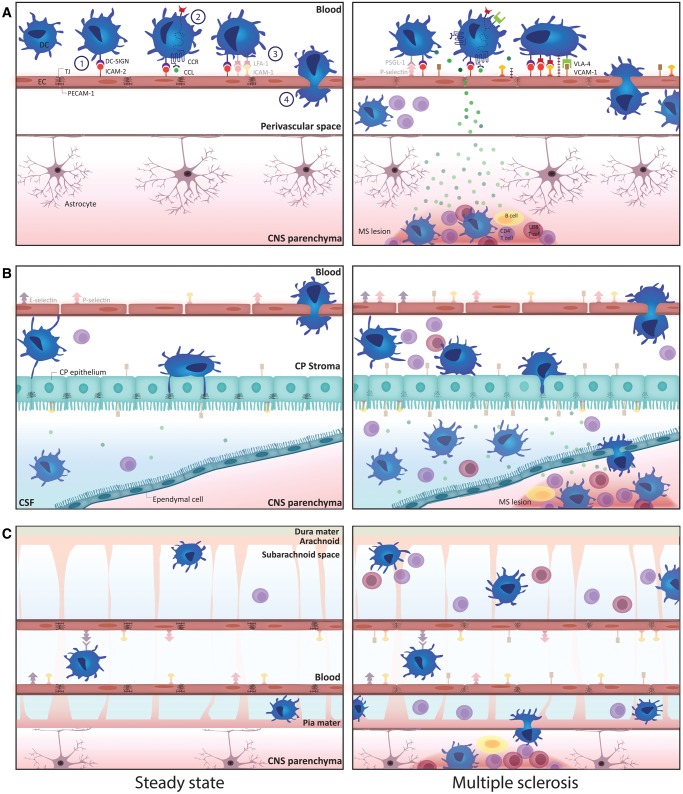Figure 1.
Schematic overview of the paths for transmigration of DC to the CNS via the blood-brain barrier (A), the choroid plexus (B), and meningeal vessels (C) in the healthy (left panels) and the inflamed CNS (right panels). Transmigration of DC exiting the bloodstream occurs according to a well-defined multistep process (A, left panel). First, circulating DC gradually slow down through engaging in DC-SIGN-mediated tethering and rolling interactions with ICAM-2 [1]. After integrin activation through chemokine signaling [2], DC firmly adhere to the endothelium [3]. Finally, DC transmigrate through the endothelial layer [4]. Under steady-state conditions, DC reside in the perivascular space and do not infiltrate into the CNS parenchyma. Under inflammatory conditions, adhesion molecule expression by BBB endothelial cells and DC is increased, facilitating DC entry into the inflamed CNS (A, right panel). In the healthy CNS, DC can be identified in the choroid plexus stroma and in the CSF-filled ventricular spaces and subarachnoid space (B and C, left panels). Their numbers drastically increase during neuroinflammation (B and C, right panels). Moreover, DC in the CSF gain access to the CNS parenchyma during MS pathogenesis (B and C, right panels). Although several ligands of DC migratory molecules are expressed by the choroid plexus endothelium and epithelium (B) as well as by the meningeal vessel endothelium (C) and their expression is further increased under inflammatory conditions, it remains to be determined which of these are critical in guiding DC through these barriers during immune surveillance of the CNS as well as during neuroinflammation. (For opaque molecules, involvement in the process of DC migration to the CNS has been documented in scientific literature. Transparent molecules are described to be expressed by DC and at the CNS barriers and therefore could also be involved in DC migration to the CNS, but these interactions between the specific molecule pairs have not [yet] been proven to occur during DC migration to the CNS). BBB, blood-brain barrier; CCL, chemokine ligand; CCR, chemokine receptor; CNS, central nervous system; CP, choroid plexus; CSF, cerebrospinal fluid; DC, dendritic cell; DC-SIGN, dendritic cell-specific ICAM-grabbing nonintegrin; ICAM-1, intercellular adhesion molecule-1; ICAM-2, intercellular adhesion molecule-2; LFA-1, lymphocyte function-associated antigen-1; MS, multiple sclerosis; PECAM-1, platelet and endothelial cell adhesion molecule-1; PSGL-1, P-selectin glycoprotein ligand-1; VCAM-1, vascular cell adhesion molecule-1; VLA-4, very late antigen-4.

